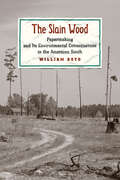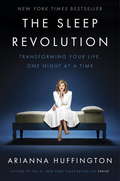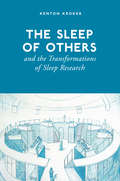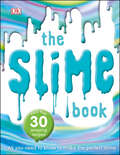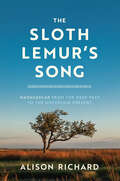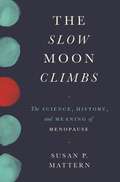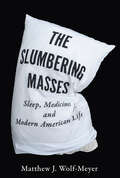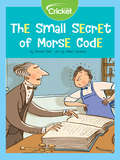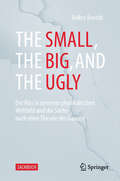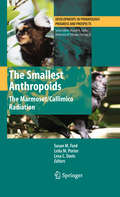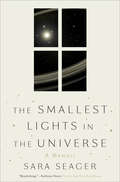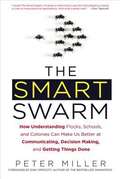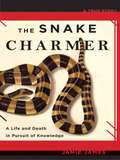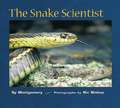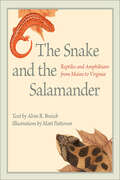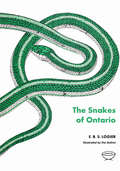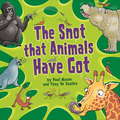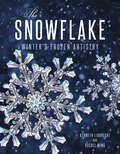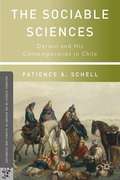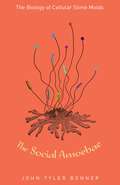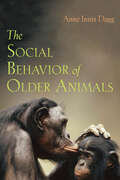- Table View
- List View
The Slain Wood: Papermaking and Its Environmental Consequences in the American South (Studies in Industry and Society)
by William BoydThe paper industry rejuvenated the American South—but took a heavy toll on its land and people.When the paper industry moved into the South in the 1930s, it confronted a region in the midst of an economic and environmental crisis. Entrenched poverty, stunted labor markets, vast stretches of cutover lands, and severe soil erosion prevailed across the southern states. By the middle of the twentieth century, however, pine trees had become the region’s number one cash crop, and the South dominated national and international production of pulp and paper based on the intensive cultivation of timber.In The Slain Wood, William Boyd chronicles the dramatic growth of the pulp and paper industry in the American South during the twentieth century and the social and environmental changes that accompanied it. Drawing on extensive interviews and historical research, he tells the fascinating story of one of the region’s most important but understudied industries. The Slain Wood reveals how a thoroughly industrialized forest was created out of a degraded landscape, uncovers the ways in which firms tapped into informal labor markets and existing inequalities of race and class to fashion a system for delivering wood to the mills, investigates the challenges of managing large papermaking complexes, and details the ways in which mill managers and unions discriminated against black workers. It also shows how the industry’s massive pollution loads significantly disrupted local environments and communities, leading to a long struggle to regulate and control that pollution.
The Sleep Revolution: Transforming Your Life, One Night at a Time
by Arianna HuffingtonWe are in the midst of a sleep deprivation crisis, writes Arianna Huffington, the co-founder and editor in chief of The Huffington Post. And this has profound consequences - on our health, our job performance, our relationships and our happiness. What is needed, she boldly asserts, is nothing short of a sleep revolution. Only by renewing our relationship with sleep can we take back control of our lives. In her bestseller Thrive, Arianna wrote about our need to redefine success through well-being, wisdom, wonder, and giving. Her discussion of the importance of sleep as a gateway to this more fulfilling way of living struck such a powerful chord that she realized the mystery and transformative power of sleep called for a fuller investigation. The result is a sweeping, scientifically rigorous, and deeply personal exploration of sleep from all angles, from the history of sleep, to the role of dreams in our lives, to the consequences of sleep deprivation, and the new golden age of sleep science that is revealing the vital role sleep plays in our every waking moment and every aspect of our health - from weight gain, diabetes, and heart disease to cancer and Alzheimer's. In The Sleep Revolution, Arianna shows how our cultural dismissal of sleep as time wasted compromises our health and our decision-making and undermines our work lives, our personal lives -- and even our sex lives. She explores all the latest science on what exactly is going on while we sleep and dream. She takes on the dangerous sleeping pill industry, and all the ways our addiction to technology disrupts our sleep. She also offers a range of recommendations and tips from leading scientists on how we can get better and more restorative sleep, and harness its incredible power. In today's fast-paced, always-connected, perpetually-harried and sleep-deprived world, our need for a good night's sleep is more important - and elusive -- than ever. The Sleep Revolution both sounds the alarm on our worldwide sleep crisis and provides a detailed road map to the great sleep awakening that can help transform our lives, our communities, and our world.From the Hardcover edition.
The Sleep of Others and the Transformation of Sleep Research
by Kenton KrokerWe tend to think of sleep as a private concern, a night-time retreat from the physical world into the realm of the subconscious. Yet sleep also has a public side; it has been the focal point of religious ritual, philosophic speculation, political debate, psychological research, and more recently, neuroscientific investigation and medical practice.In this first ever history of sleep research, Kenton Kroker draws on a wide range of material to present the story of how an investigative field - at one time dominated by the study of dreams - slowly morphed into a laboratory-based discipline. The result of this transformation, Kroker argues, has changed the very meaning of sleep from its earlier conception to an issue for public health and biomedical intervention.Examining a vast historical period of 2500 years, Kroker separates the problems associated with the history of dreaming from those associated with sleep itself and charts sleep-related diseases such as narcolepsy, insomnia, and sleep apnea. He describes the discovery of rapid eye movement - REM - during the 1950s, and shows how this discovery initiated the creation of 'dream laboratories' that later emerged as centres for sleep research during the 1960s and 1970s. Kroker's work is unique in subject and scope and will be enormously useful for both sleep researchers, medical historians, and anybody who's ever lost a night's sleep.
The Slime Book: All You Need to Know to Make the Perfect Slime
by DKOver 30 delightfully gloopy, gooey, colorful DIY recipes will mesmerize youngsters by showing them how to make slime.Play, poke, push, pull, and pop fabulous easy-to-follow slime recipes. They are all tried and tested by our slime experts, so you don't have to search the vast digital plains for the perfect recipe. Create monster slime with googly eyes, bite into some yummy edible chocolate slime, and see the rainbow with unicorn slime.All projects in this kid's ebook are shown with clear step-by-step images and a vibrant image of the final product in all its slimy glory! Learn the science behind these slime creations with amazing fun facts and carry on the fun with recipe variations. The latest in addictive kids' activities, making your slime is the ultimate sticky and squidgy fun.All slime recipes are borax-free, and with online recipes varying so drastically, it's nice to know that your slime-y masterpieces will come out perfect on the first try. Making slime is currently one of the most popular trends for children, with some homemade slime videos reaching 30-million views. With 30 recipes, The Slime Book includes more variations than any slime ebook available, and all recipes use safe and readily available ingredients. Science information boxes add an educational element to the ebook without detracting from the fun.Ideal for children ages 5-9 who are new to the slime trend or who are already obsessed with slime and looking for new, funky recipes. Get Ready To Slime!From basic slime to edible, textured, glow-in-the-dark, and color-changing slime - there's something for everyone! Kids will be mesmerized and "slimerized" by the ebook's gloopy, gooey, colorful slime recipes. Create a volcanic slime eruption, gross-out your friends with snot slime, and tuck into tasty chocolatey slime. Simple step-by-steps and vibrant photographs show how to create awesome slime, every time. Each recipe uses safe, readily available ingredients, so you can start pulling and poking straight away. Get ready to become slime extraordinaire, making:- Glitter slime- Pompom slime- Alphabet slime- Glow in the dark slime - Magnetic slime- Dinosaurs in Amber slime and much more! This ebook was such a hit that DK released a second "slimetastic" title! Try Super Slime next, packed with another 30 innovative recipes your little ones will love to try!
The Sloth Lemur's Song: Madagascar from the Deep Past to the Uncertain Present
by Alison RichardA moving account of Madagascar told by a researcher who has spent over fifty years investigating the mysteries of this remarkable island. Madagascar is a place of change. A biodiversity hotspot and the fourth largest island on the planet, it has been home to a spectacular parade of animals, from giant flightless birds and giant tortoises on the ground to agile lemurs leaping through the treetops. Some species live on; many have vanished in the distant or recent past. Over vast stretches of time, Madagascar’s forests have expanded and contracted in response to shifting climates, and the hand of people is clear in changes during the last thousand years or so. Today, Madagascar is a microcosm of global trends. What happens there in the decades ahead can, perhaps, suggest ways to help turn the tide on the environmental crisis now sweeping the world. The Sloth Lemur’s Song is a far-reaching account of Madagascar’s past and present, led by an expert guide who has immersed herself in research and conservation activities with village communities on the island for nearly fifty years. Alison Richard accompanies the reader on a journey through space and time—from Madagascar’s ancient origins as a landlocked region of Gondwana and its emergence as an island to the modern-day developments that make the survival of its array of plants and animals increasingly uncertain. Weaving together scientific evidence with Richard’s own experiences and exploring the power of stories to shape our understanding of events, this book captures the magic as well as the tensions that swirl around this island nation.
The Slow Moon Climbs: The Science, History, and Meaning of Menopause
by Susan MatternThe first comprehensive look at menopause from prehistory to todayAre the ways we look at menopause all wrong? Historian Susan Mattern says yes, and The Slow Moon Climbs reveals just how wrong we have been. Taking readers from the rainforests of Paraguay to the streets of Tokyo, Mattern draws on historical, scientific, and cultural research to reveal how our perceptions of menopause developed from prehistory to today. For most of human history, people had no word for menopause and did not view it as a medical condition. Rather, in traditional foraging and agrarian societies, it was a transition to another important life stage. This book, then, introduces new ways of understanding life beyond fertility.Mattern examines the fascinating "Grandmother Hypothesis"—which argues for the importance of elders in the rearing of future generations—as well as other evolutionary theories that have generated surprising insights about menopause and the place of older people in society. She looks at agricultural communities where households relied on postreproductive women for the family’s survival. And she explores the emergence of menopause as a medical condition in the Western world. It was only around 1700 that people began to see menopause as a dangerous pathological disorder linked to upsetting symptoms that rendered women weak and vulnerable. Mattern argues that menopause was another syndrome, like hysterical suffocation or melancholia, that emerged or reemerged in early modern Europe in tandem with the rise of a professional medical class.The Slow Moon Climbs casts menopause, at last, in the positive light it deserves—not only as an essential life stage, but also as a key factor in the history of human flourishing.
The Slumbering Masses: Sleep, Medicine, and Modern American Life (A Quadrant Book)
by Matthew J. Wolf-MeyerAmericans spend billions of dollars every year on drugs, therapy, and other remedies trying to get a good night&’s sleep. Anxieties about not getting enough sleep and the impact of sleeplessness on productivity, health, and happiness pervade medical opinion, the workplace, and popular culture. In The Slumbering Masses, Matthew J. Wolf-Meyer addresses the phenomenon of sleep and sleeplessness in the United States, tracing the influence of medicine and industrial capitalism on the sleeping habits of Americans from the nineteenth century to the present.Before the introduction of factory shift work, Americans enjoyed a range of sleeping practices, most commonly two nightly periods of rest supplemented by daytime naps. The new sleeping regimen—eight uninterrupted hours of sleep at night—led to the pathologization of other ways of sleeping. Arguing that the current model of sleep is rooted not in biology but in industrial capitalism&’s relentless need for productivity, The Slumbering Masses examines so-called Z-drugs that promote sleep, the use of both legal and illicit stimulants to combat sleepiness, and the contemporary politics of time. Wolf-Meyer concludes by exploring the extremes of sleep, from cases of perpetual sleeplessness and the use of the sleepwalking defense in criminal courts to military experiments with ultra-short periods of sleep.Drawing on untapped archival sources and long-term ethnographic research with people who both experience and treat sleep abnormalities, Wolf-Meyer analyzes and sharply critiques how sleep and its supposed disorders are understood and treated. By recognizing the variety and limits of sleep, he contends, we can establish more flexible expectations about sleep and, ultimately, subvert the damage of sleep pathology and industrial control on our lives.
The Small Secret of Morse Code
by Pamela DellWant to know about the dots and dashes of Morse code? Learn how Morse code came into being and became less time-consuming and more efficient.
The Small, the Big, and the Ugly: Der Riss in unserem physikalischen Weltbild und die Suche nach einer Theorie des Ganzen
by Volker KnechtDie beiden Säulen der modernen Physik sind die Quantenmechanik zur Beschreibung der subatomaren Welt sowie die allgemeine Relativitätstheorie zum Verständnis der Gravitation und des Universums. Zwischen diesen Theorien der ganz kleinen und ganz großen Dinge klafft in unserem physikalischen Weltbild ein hässlicher Riss. Ihn zu schließen und die Welt in einer vereinheitlichten Theorie des Ganzen zu beschreiben, ist der Heilige Gral der Physik. Der Schlüsselschritt hierbei ist die Vereinigung der Quantenmechanik und der allgemeinen Relativitätstheorie zu einer übergreifenden Theorie der Quantengravitation. Der Autor beschreibt die Entwicklung der Physik von der Antike bis heute und diskutiert kritisch die Wege zu einer vereinheitlichenden Theorie. Ist die Welt superdeterministisch oder supersymmetrisch? Sind die kleinsten Teilchen winzige schwingende Saiten? Ist die Stringtheorie die Weltformel, oder ist sie bereits widerlegt? Ist die Schleifenquantengravitation der Königs- oder ein weiterer Holzweg? Müssen wir die Gravitation quantisieren oder die Quanten gravitieren? Dr. Volker Knecht erklärt mit unerhörter Klarheit und Prägnanz das Dilemma der modernen Physik.
The Smallest Anthropoids
by Leila M. Porter Susan M. Ford Lesa C. DavisThis volume represents a comprehensive examination of the newly recognized callimico/marmoset clade, which includes the smallest anthropoid primates on earth. It will explore these diminutive primates in their entirety, with sections on phylogeny, taxonomy and functional anatomy, behavioral ecology, reproductive physiology, as well as address critical conservation issues and the need for conservation action. The topics specifically selected for this volume are pivotal for understanding the evolutionary adaptations and divergence of any primate group, and especially one as diverse and curious as this. The discoveries of new taxa over the last fifteen years along with new genetic data have transformed this group from three genera (one with only a distant relationship to the others) and five recognized species, to five closely related genera, comprising at least 22 species. This volume will be the first to synthesize data on these newly recognized taxa. This volume is an international endeavor, bringing together primary callimico and marmoset researchers from around the globe, including Brazil and the United States as well as Greece, Italy, Switzerland, and Germany. One of the merits of this volume is that it will serve as a readily accessible work that includes the major findings of several key international researchers whose work has not been easily available to English-speaking scholars. In addition, it draws together lab and field researchers, geneticists, anatomists, and behaviorists in an integrated volume that will provide the most detailed and thorough work on either callimicos or marmosets to date. This volume will also provide a timely forum for identifying future avenues of action necessary for more fully understanding and protecting this intriguing primate radiation.
The Smallest Lights in the Universe: A Memoir
by Sara SeagerCanadian MIT astrophysicist Sara Seager interweaves the story of her search for meaning and solace after losing her first husband to cancer, her unflagging search for an Earth-like exoplanet and her unexpected discovery of new love.Sara Seager has made it her life's work to peer into the spaces around stars--looking for exoplanets outside our solar system, hoping to find the one-in-a-billion world enough like ours to sustain life. But with the unexpected death of her husband, her life became an empty, lightless space. Suddenly, she was the single mother of two young boys, a widow at forty, clinging to three crumpled pages of instructions her husband had written for things like grocery shopping--things he had done while she did pioneering work as a planetary scientist at MIT. She became painfully conscious of her Asperger's, which before losing her husband had felt more like background noise. She felt, for the first time, alone in the universe.In this probing, invigoratingly honest memoir, Seager tells the story of how, as she stumblingly navigated the world of grief, she also kept looking for other worlds. She continues to develop groundbreaking projects, such as the Starshade, a sunflower-shaped instrument that, when launched into space, unfurls itself so as to block planet-obscuring starlight, and she takes solace in the alien beauty of exoplanets. At the same time, she discovers what feels every bit as wondrous: other people, reaching out across the space of her grief. Among them are the Widows of Concord, a group of women offering consolation and advice, and her beloved sons, Max and Alex. Most unexpected of all, there is another kind of one-in-a-billion match with an amateur astronomer. Equally attuned to the wonders of deep space and human connection, The Smallest Lights in the Universe is its own light in the dark.
The Smallest Lights in the Universe: A Memoir
by Sara SeagerIn this luminous memoir, an MIT astrophysicist must reinvent herself in the wake of tragedy and discovers the power of connection on this planet, even as she searches our galaxy for another Earth.Sara Seager has always been in love with the stars: so many lights in the sky, so much possibility. Now a pioneering planetary scientist, she searches for exoplanets—especially that distant, elusive world that sustains life. But with the unexpected death of Seager&’s husband, the purpose of her own life becomes hard for her to see. Suddenly, at forty, she is a widow and the single mother of two young boys. For the first time, she feels alone in the universe.As she struggles to navigate her life after loss, Seager takes solace in the alien beauty of exoplanets and the technical challenges of exploration. At the same time, she discovers earthbound connections that feel every bit as wondrous, when strangers and loved ones alike reach out to her across the space of her grief. Among them are the Widows of Concord, a group of women offering advice on everything from home maintenance to dating, and her beloved sons, Max and Alex. Most unexpected of all, there is another kind of one-in-a-billion match, not in the stars but here at home.Probing and invigoratingly honest, The Smallest Lights in the Universe is its own kind of light in the dark.
The Smart Swarm
by Peter MillerWhat ants, bees, fish, and smart swarms can teach about communication, organization, and decision-making. The modern world may be obsessed with speed and productivity, but twenty-first-century humans actually have much to learn from the ancient instincts of swarmers. A fascinating new take on collective intelligence and its colorful manifestations in some of our most complex problems, The Smart Swarm introduces a compelling new understanding on solving our own problems relating to such topics as business, politics, and technology. This lively tour from National Geographic reporter Peter Miller introduces ant colonies that have been the inspiration for streamlining factory processes, telephone networks, and truck routes; termites, used in studies for climate-control solutions; schools of fish, on which the U.S. military modeled a team of robots; and many other examples of the wisdom to be gleaned about the behavior of crowds.
The Snake Charmer: A Life and Death in Pursuit of Knowledge
by Jamie JamesAlthough it was still too dark to see well, Joe absentmindedly thrust his right hand into the sack to extract the specimen and have a look. Immediately, he winced with pain and yanked out his hand. A tiny black-and-white banded snake, less than ten inches long, was dangling limply from his middle finger, its fangs still sunk into his flesh. In the fall of 2001, deep in the jungle of Burma, a team of scientists is searching for rare snakes. They are led by Dr. Joe Slowinski, at forty already one of the most brilliant biologists of our time. It is the most ambitious scientific expedition ever mounted into this remote region, venturing into the foothills of the Himalayas. The bold undertaking is brought to a dramatic halt by the bite of the many-banded krait, the deadliest serpent in Asia. In the moment he pulled his hand from the specimen bag and saw the krait, Joe knew that his life was in grave and imminent peril. Thus began one of the most remarkable wilderness rescue attempts of modern times, as Joe's teammates kept him alive for thirty hours by mouth-to-mouth respiration, waiting for a rescue that never came. A daredevil obsessed with venomous snakes since his youth, Slowinski was a modern-day adventurer who rose quickly to the top of his field, discovering many previously unidentified snake species in his brief yet exhilarating career. The Snake Charmer is at once brilliant biography and exotic travel literature, blended with an accessible introduction to the bizarre, fascinating-and sometimes controversial-world of snake science. The narrative transports the reader into primeval wilderness, from the Everglades to Peru to Burma, in search of rattlesnakes and boa constrictors, kraits and cobras. Joe Slowinski's career was fast and exciting, his tragic final expedition a pulse-pounding struggle between man and nature. In The Snake Charmer, renowned journalist and author Jamie James captures the life and death of this charismatic, endlessly fascinating man. Exhaustively researched in interviews with Slowinski's colleagues and family, and the author's own trek into the wilds of Burma, this is narrative nonfiction in the tradition of Into the Wild and The Perfect Storm.
The Snake Scientist
by Sy MontgomeryDiscusses the work of Bob Mason and his efforts to study and protect snakes, particularly red-sided garter snakes. For children.
The Snake and the Salamander: Reptiles and Amphibians from Maine to Virginia
by Alvin R. BreischA beautifully illustrated tour of the region’s snakes, lizards, turtles, frogs, and salamanders.Winner of the National Outdoor Book Award of the NOBA Foundation (Nature and Environment Category)In the best tradition of natural history writing and art, The Snake and the Salamander explores the diverse collection of reptiles and amphibians that inhabit the northeastern quadrant of the United States. Covering 13 states that run from Maine to Virginia, author Alvin R. Breisch and artist Matt Patterson showcase the lives of 83 species of snakes, lizards, turtles, frogs, and salamanders. These intriguing animals are organized by habitat and type, from forest to grassland to bogs to big waters, and revealed through a combination of Breisch’s engaging prose and Patterson’s original color illustrations. Breisch’s guided tour combines historical notes and conservation issues with lessons on genetics, evolution, habitats, life histories, and more. Discover how careful attention to frog calls coupled with DNA analysis led to the discovery of a new species of frog in New York City, why evolutionary adaptations made the Eastern Ratsnake a superb climber, and the surprising fact that Spiny Softshell turtles actually sprint on land to retreat from predators. Breisch also tells the odd tale of the Green Frog and the Smooth Greensnake, two "green species" that do not actually have any green pigment in their skin. Every species has a story to tell—one that will keep the reader wanting to learn more.The breadth of herpetofauna in the area will surprise many readers: more than 8% of the world’s salamanders and 11% of all turtle species live in the region. Beyond numbers, however, lie aesthetics. The surprising colors and fascinating lifestyles of the reptile and amphibian species in this book will mesmerize readers young and old.
The Snake and the Salamander: Reptiles and Amphibians from Maine to Virginia
by Alvin R. BreischA beautifully illustrated tour of the region’s snakes, lizards, turtles, frogs, and salamanders.In the best tradition of natural history writing and art, The Snake and the Salamander explores the diverse collection of reptiles and amphibians that inhabit the northeastern quadrant of the United States. Covering thirteen states that run from Maine to Virginia, author Alvin R. Breisch and artist Matt Patterson showcase the lives of 83 species of snakes, lizards, turtles, frogs, and salamanders. These intriguing animals are organized by habitat and type, from forest to grassland to bogs to big waters, and revealed through a combination of Breisch’s engaging prose and Patterson’s original color illustrations.Breisch’s guided tour combines historical notes and conservation issues with lessons on genetics, evolution, habitats, life histories, and more. Discover how careful attention to frog calls coupled with DNA analysis led to the discovery of a new species of frog in New York City, why evolutionary adaptations made the Eastern Ratsnake a superb climber, and the surprising fact that Spiny Softshell turtles actually sprint on land to retreat from predators. Breisch also tells the odd tale of the Green Frog and the Smooth Greensnake, two “green species” that do not actually have any green pigment in their skin. Every species has a story to tell?one that will keep the reader wanting to learn more.The breadth of herpetofauna in the area will surprise many readers: more than 8% of the world’s salamanders and 11% of all turtle species live in the region. Beyond numbers, however, lie aesthetics. The surprising colors and fascinating lifestyles of the reptile and amphibian species in this book will mesmerize readers young and old.Winner of the National Outdoor Book Award of the NOBA Foundation (Nature and Environment Category)“The breadth of herpetofauna in the area will surprise many readers: more than 8% of the world’s salamanders and 11% of all turtle species live in the region. Beyond numbers, however, lie aesthetics. The surprising colors and fascinating lifestyles of the reptile and amphibian species in this book will mesmerize readers young and old.” —The Birdbooker Report“While most field guides are organized by species, this book is more than a field guide; it places the animals in the context of their environment.” —The Altamont Enterprise
The Snakes of Ontario
by E.B.S. LogierMany people have a great fear of snakes. This fear affects their peace of mind, their enjoyment of a holiday in the country, and even their pleasure in their own suburban gardens. It leads to the senseless destruction of one of our valuable natural resources. The morbid fear of snakes can only be dispelled by learning the true facts about these fascinating creatures. This book is addressed to anyone who wishes to learn about the natural history of snakes, or to identify those found in Ontario, but the author speaks particularly to young people, who, unless they have been prejudiced, have a natural interest in all living things. In an easy, conversational manner, the author gives a general account of snakes--what they are, how they travel, their instinct and intelligence, how they feed, their reproduction, hiberation, shedding of the skin, defences usefulness--and discusses popular beliefs and fear of snakes. The separate species are fully described in a simple, non-technical and readable style. The author is also an artist, and the book is illustrated with his own wash drawings and line sketches. There are two beautiful colour plates. Distribution maps show the range of species. For those wishing to pursue the study of snakes more fully, an appendix provides a list of snakes with scientific names, a key for the identification of the snakes, directions for determining their sex, directions for collection and preserving, directions for determining their sex, directions for keeping snakes as pets, diagrams giving anatomical names of parts of snakes, a glossary, and a concise and up-to-date outline of rattlesnake bite and first aid treatment.
The Snot That Animals Have Got
by Paul MasonWhat is snot? How is it useful? What do animals do with it? Why is there so much? Find out the science behind the green goo and it's fascinating uses in the animal kingdom with this gross-filled guide!Highly accessible text from expert non-fiction author Paul Mason combines with fun photographs and highly amusing artwork from Tony De Saulles to create a visual feast of information. Extra facts are packed into the back of the book so you can top trump friends on your snot knowledge!Full of scientific facts, it's also a perfect teaching tool for curious minds aged 7+Other unmissable books in this yuk-filled series:The Poo that Animals DoThe Wee that Animals PeeThe Farts that Animals Parp
The Snow Booklet: A Guide to the Science, Climatology, and Measurement of Snow in the United States (2nd edition)
by Nolan J. Doesken Arthur JudsonWritten for climatological observers and their managers, snow-fighters, urban planners, winter recreationists, and all who find in snow a sense of inspiration and awe, this profusely illustrated book provides a wealth of snow data. Contents: the power and beauty of snow; the science of snow; climatology of snow in the U. S. ; measuring snow; problems and challenges in measuring snow; procedure for measuring snow; dealing with adversity (blizzards); common questions about snow; and more. Illustrated with comparative charts and graphs, diagrams, and black and white and color photos. Bibliography. Glossary of snow terms.
The Snowflake: Winter's Frozen Artistry
by Kenneth Libbrecht Rachel WingA chronicle of snow crystal creation from the Caltech physicist known as the world’s leading snowflake expert and consultant for the movie Frozen.Snowflakes may be an everyday, common subject, but you’ve never seen them like this! A collection of amazing photography of snow crystals using a unique system designed to take super-detailed micro images of these miniature ice masterpieces, The Snowflake is an extraordinary look at a seemingly ordinary object. Author Kenneth Libbrecht, a physics professor at Caltech and the pre-eminent snow-crystal researcher, discusses the physics and mythology of snow and how snow crystals are made. Photographer Patricia Rasmussen presents remarkable color micro-photography of snowflakes, and also discusses the history of snow-crystal micro-photography as invented by farmer Wilson Bentley.“What better way to teach your children to truly appreciate the beauty of nature than them seeing snow with their own eyes and then going on this journey with The Snowflake: Winter’s Frozen Artistry. Nothing else shows the miracle that is nature better than this book.” —The Palmetto Queen blog
The Sociable Sciences
by Patience A. SchellThis beautifully written history traces the fortunes of Charles Darwin and his contemporaries in Chile. It explains how they showed Chileans a new way to see their own natural environment, teaching a younger generation of scientists there and forging international networks that helped to shape the modern world.
The Social Amoebae: The Biology of Cellular Slime Molds
by John Tyler BonnerNoted biologist and author John Tyler Bonner has experimented with cellular slime molds for more than sixty years, and he has done more than anyone else to raise these peculiar collections of amoebae from a minor biological curiosity to a major model organism--one that is widely studied for clues to the development and evolution of all living things. Now, five decades after he published his first pioneering book on cellular slime molds, Bonner steps back from the proliferating and increasingly specialized knowledge about the organism to provide a broad, nontechnical picture of its whole biology, including its evolution, sociobiology, ecology, behavior, and development. The Social Amoebae draws the big lessons from decades of research, and shows how slime molds fit into and illuminate biology as a whole. Slime molds are very different from other organisms; they feed as individual amoebae before coming together to form a multicellular organism that has a remarkable ability to move and orient itself in its environment. Furthermore, these social amoebae display a sophisticated division of labor; within each organism, some cells form the stalk and others become the spores that will seed the next generation. In The Social Amoebae, Bonner examines all these parts together, giving a balanced, concise, and clear overview of slime mold biology, from molecules to cells to multicells, as he advances some unconventional and unexpected insights.
The Social Behavior of Older Animals
by Anne Innis DaggHow do young and old social animals view each other? Are aged animals perceived by others as weaker? Or wiser? What is the relationship between age and power among social animals?Taking a cue from Frans de Waal’s seminal work examining the lives of chimpanzees, Anne Innis Dagg in this pioneering study probes the lives of older mammals and birds. Synthesizing the available scientific research and anecdotal evidence, she explores how aging affects the lives and behavior of animals ranging from elk to elephants and gulls to gorillas, examining such topics as longevity; how others in a group view senior members in regard to leadership, wisdom, and teaching; mating success; interactions with mates and offspring; how aging affects dominance; changes in aggressive behavior and adaptability; and death and dying. At once instructive and compelling, this theme-spanning book reveals the complex nature of maturity in scores of social species and shows that animal behavior often displays the same diversity we find in ourselves.
The Social Behavior of Older Animals
by Anne Innis DaggA groundbreaking study on the lives of senior mammals and birds—from the aging of alphas to the role of grandmothers—by the author of Animal Friendships. How do young and old social animals view each other? Are aged animals perceived by others as weaker? Or wiser? What is the relationship between age and power among social animals?Taking a cue from Frans de Waal’s seminal work examining the lives of chimpanzees, Anne Innis Dagg in this pioneering study probes the lives of older mammals and birds. Synthesizing the available scientific research and anecdotal evidence, she explores how aging affects the lives and behavior of animals ranging from elk to elephants and gulls to gorillas, examining such topics as longevity; how others in a group view senior members in regard to leadership, wisdom, and teaching; mating success; interactions with mates and offspring; how aging affects dominance; changes in aggressive behavior and adaptability; and death and dying.At once instructive and compelling, this theme-spanning book reveals the complex nature of maturity in scores of social species and shows that animal behavior often displays the same diversity we find in ourselves.“Dagg’s book should be a corrective to us all; species that lose or ignore the contributions of their older members do so at their peril.” —Literary Review of Canada“Humans and chimps, it turns out, value age in sexual partners very differently. In our species youth is prized, but among chimps the reverse is the case.” —The New York Review of Books
